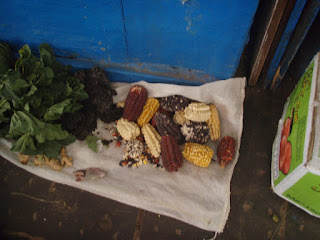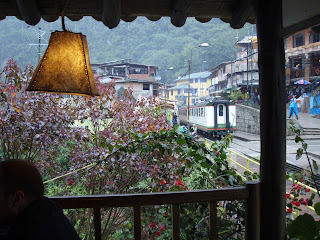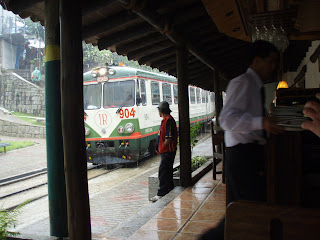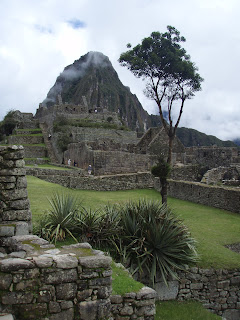Sorry folks, for not getting this finished - there will be more about the schools and then our train ride down south to Puno, on the edge of Lake Titicaca. Then floating islands, temples on top of other islands and dancing/music festival in Puno.
Away this coming week, then I'll sort it!
Jane was in Brazil in 2001 with our daughter Kate, during Kate's Medical Elective there - neither has stopped raving about it since. Now retired, we plan to combine a Peru trip with a recce to see how we could medically help some of the most impoverished rural communities in the Cusco area. We plan to tour but also to visit the WAWA Project, to see what potential there may be for us to provide some input - please see their website details below, under 'Welcome'.
Followers
Saturday, 12 March 2011
Monday, 28 February 2011
School visits - Conchacalle
Conchacalle

Mary, with one of the schoolboys along the path up to the village.
The children were very happy, friendly and welcoming.
The children were very happy, friendly and welcoming.
The school's head teacher, Odolon, with Millie, the Peruvian WAWA co-ordinator.
The children enjoy the mangoes, but only after being supervised
in washing them under the school tap.
Last year's new buildings for the school
Projects board with photos and architect's plans.
Mary and Millie with some of the pupils. The children were
on holiday, but a good number of them met us on the day.
Photos of previous project, restoration of the very unsafe and unusable buildings.
WAWA helped with converting what was previously a rudimentary greenhouse,
into the Catherine Anderson Memorial Building, which is now the largest
classroom for the school. It also doubles as a much-valued community hall.
WAWA helped with converting what was previously a rudimentary greenhouse,
into the Catherine Anderson Memorial Building, which is now the largest
classroom for the school. It also doubles as a much-valued community hall.
Same
Inside the Catherine Anderson Memorial building. They still had
the Nativity displayon show at the end of January!
the Nativity displayon show at the end of January!
 |
| Relaxation ... |
... and weaving lessons.
View across valley - even at this altitude and wet environment for much of the year,
they use adobe mud bricks - see the stack beyond our canine friend.
Another recent classroom provided by WAWA
 |
Musical instruments provided by WAWA
An impromptu 'concert'
This octagonal building at the top of the slope was built originally
by visiting nuns 'to allow the locals to admire the view'(!)
WAWA converted it into a pre-school classroom.
We were honoured to join Odolon and some of the parents to potatoes ...
... and roast guineapig.
Part of the nuns' viewpoint, converted into the school playground.
Mary and Chris with 4 of last year's 5 scholarship students, who now
attend the senior school in Cusco, 14 Km away. They walk there and
back each day.Most of the pupils have no chance of further education
because of the expense as well as the geography.
Off to the next school ...
village church on the right.
Monday, 21 February 2011
Preparing for school visits
Back in Cusco, we met with Chris and Mary a couple of days after they arrived in Lima.
We visited the local Medical Centre, which is like a Community Hospital,with the usual clinics, and Surgery rolled into one (they don't have separate family doctor services). This was to liaise with them and find out what, if anything, we might be able to do to help improve medical services to the outlying schools/communities.
It transpired that there was very little we could or needed to do, as the services are pretty comprehensive.
Fresh fruit juice stall
Spoilt for choice
Prickly pears (fruit of the prickly pear cactus).
Tasty, but lots of hard seeds - very good for bunging
you up if you eat too much of them.
Those pale white objects bottom right are a great Peruvian delicacy,
especially for the Quechua Indians. Called 'dried potatoes'
they are the most disgusting thing ever created.

There is a wide variety of maize. The black maize is used to make Chicha,
an alcoholic drink. It is very good at lowering cholesterol levels
The school children rarely see any fruit and it's always appreciated if you take some fruit (their favourite is mangoes) as a gift. So the first stop is one of the many fruit markets!
Agua Calientes
You can get to Machu Picchu either by the Inca trail, or instead by train (which we did) via Agua Calientes. From there it's a bus shuttle up to Machu Picchu.
Last year the rainy season started in January with torrential rains which flooded out Agua Calientes and destroyed a lot of the town and rail, cutting the area off for 3 months. It was something of a local disaster with a lot of stranded locals and tourists resulting in much hardship, especially for those who had little money to get help. The government did'nt offer as much assistance as they could have done, partly because they'd just given something like $10M to the Haiti disaster. This caused a lot of bitterness.
View up the river, anticipating a vast tsunami....
Most of the above was devastated last year
Friday, 18 February 2011
and a few more
Still at Machu Picchu ...
This wasn't me arguing with our guide (not good body language, I know)!
He was explaining the theories about the stone 'bowls' on the floor
and the 'windows' in the wall.
The windows that are blocked off, resonate very effectively if you thrust your head
inside them and hum a steady note. Some people come to do this as part
of their 'spiritual experience' here..... OMMMMmmm ...
But our guide demonstrated that by shouting into one of the windows the sound is
amplified and directed to people across the valley as a means of communication.
Some say these were mortars for grinding , but there is no sign of wear,
which you would expect. It is most likely that they were filled with water,
for astronomical observation as the Incas were keen astronomers.
Vaguely reminiscent of Galadriel's Mirror.
Wednesday, 16 February 2011
The Sacred Valley and few more of Machu Picchu
Pisac in the Sacred Valley
As we came down into the Sacred Valley we passed through
Ollantaytambo (which is described as 'a living Inca town' where the Quechua Indians have maintained the Inca traditions), and visited the Inca ruins at Pisac
terracing at Pisac
sameagain, Pisac ...
 | |||||||||||||
| The rough terraces, centre, were pre-Inca. Those on the right, Inca. |
The Inca terraces were much more skilfully designed and built. Each terrace had layers of coarse rock/boulders, with grit, sand and soil graded towards the surface. This meant there was no leaching of the invaluable finest fertile soil during the rainy season - it merely got flushed onto the next terrace, if at all. Presumably all they had to do was dress the top-most terraces with new soil each year.
A lot of these terraces are full of flowers, mostly dahlias.
Climbing up takes the breath away, in more than one sense of the word :)
This is a vicuna (vicunya) - the smallest of the camelids (llama, alpaca etc).
It produces the finest and softest hair for textiles which are extremely expensive.
One very nearly bit me!
same
Looking back across the valley:
1.Centre, just left of thatch roof - granary store on the mountainside.
2.Left of granary - face of a mountain-god whom the Incas worshiped - if you zoom right in, you can just make out his crown - a turreted building directly above his forehead.
3.Left of the face on the further slope is another building, thought to be a temple as there was no trace of it being another granary.
And below, a few more pics of Machu Picchu which we visited the next day:
If you look at the rock face of Huayna Picchu, the backdrop, you can just make out (with a little imagination!) the image of a Puma, one of the Incas' three chief gods.
The Royal Sector, far left, with the Temple of the Sun (the lighter coloured building) - very fine stonework which was originally covered in sheet-gold. The gold had been taken long before Machu Picchu was re-discovered in the early 1900's. The Temple of the Condor is right of centre.
The flame tree
Beneath the Temple of the Sun - spot the chinchilla which lives in there!
(you can only see his feet)
Window for the Solstices - aligned with the summer and winter solstices.
The Serpent Window - this window was used to introduce snakes, according
to our guidebook: presumably for ceremonial purposes.
Temple of the Sun - fine stonework, much of it carved from the resident rock.
Subscribe to:
Comments (Atom)





























































